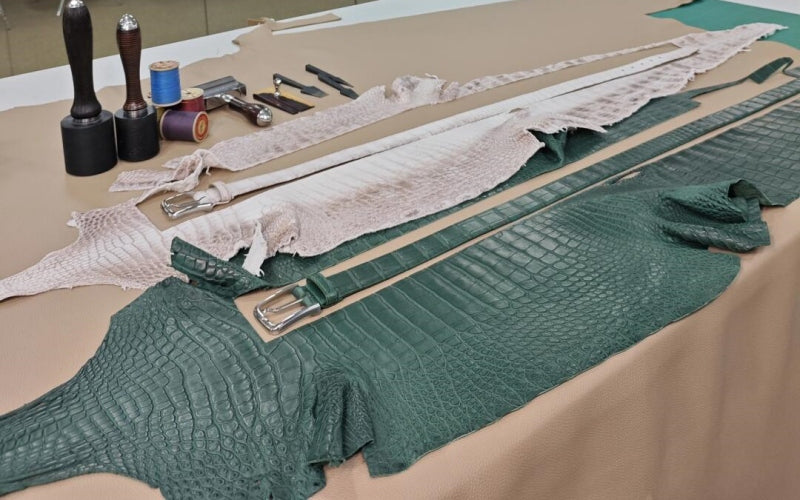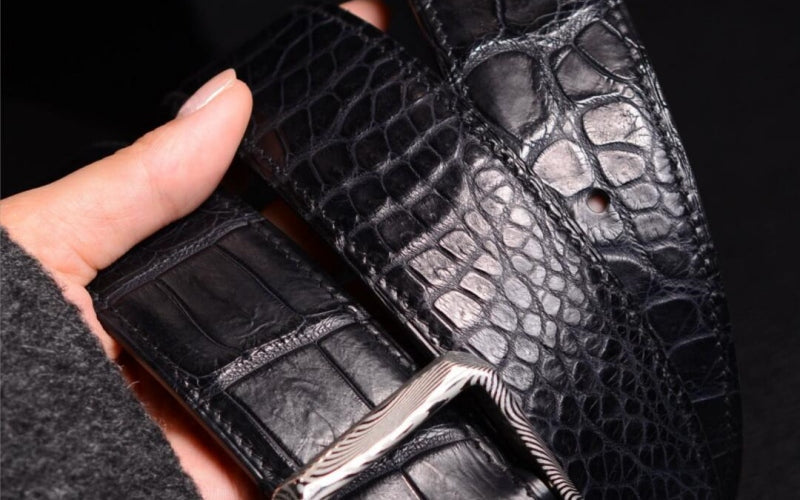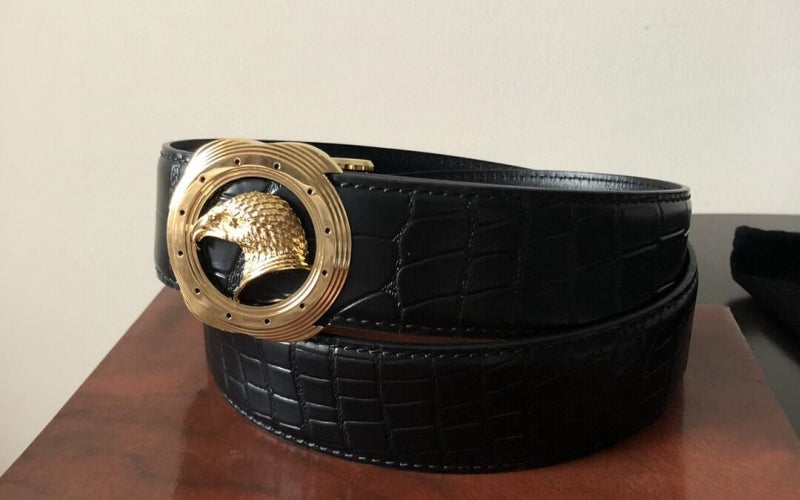
Is Alligator Leather Good Quality? (Spoiler: It’s Complicated)
So, you’re eyeing that alligator leather belt—the one that costs more than your monthly car payment. It’s sleek, it’s exotic, and it whispers, “I’ve arrived.”
But here’s the million-dollar question: Is alligator leather actually good quality, or are you just paying for the thrill of wearing a predator’s skin?
As someone who’s toured alligator farms, interviewed master tanners, and once ruined a $2,500 gator wallet by leaving it in a hot car (RIP, Larry), I’m here to unpack the truth.

1. The Short Answer: Yes, But Let’s Talk
Alligator leather is exceptionally high quality—if you define “quality” as durability, aesthetics, and exclusivity. But (and there’s always a but), it’s not for everyone. Think of it like a Ferrari: gorgeous, high-performance, and wildly impractical if you’re just picking up groceries.
Let’s break down what makes it “good”… and when it’s just overkill.
2. What Makes Alligator Leather “Good Quality”?
A. Durability: Built Like a Tank (With Better Style)
Alligator leather is tougher than your gym teacher’s whistle. Thanks to its dense, bony scales (called osteoderms), it resists scratches, water, and general human clumsiness. With proper care, a gator belt can last 20–30 years—longer than most friendships.
-
Cowhide Comparison: While cowhide is sturdy, it lacks the natural armor of alligator scales. Spill coffee on both? The cowhide stains; the gator leather laughs.
-
Flex Test: Bend a gator belt. It creases but doesn’t crack. Bend a cheap “genuine leather” belt? It’ll split like a TikTok couple.
Pro Tip: If you’re rough on accessories, gator’s your guy. If you’re gentle, even cowhide from Beltley’s Classic Line will last decades.
B. Aesthetics: Nature’s Artwork
Each alligator hide is a unique masterpiece. The pebbled texture, symmetrical belly scales, and glossy finish scream luxury without saying a word. It’s the reason brands like Hermès and Louis Vuitton charge $5,000+ for gator products—they’re selling wearable art.
-
Patina Perfection: Over time, gator leather develops a rich, golden sheen. It’s like aging into George Clooney, but for your belt.
-
Color Depth: Holds dyes better than cowhide. Want a deep emerald or metallic burgundy? Gator delivers.
Fun Fact: The most prized hides come from the belly (soft, uniform scales) and flanks (textured, rugged appeal).
C. Exclusivity: The Ultimate Flex
Let’s be real—part of gator’s allure is scarcity. Alligator farming is heavily regulated (thanks to CITES treaties), and only prime hides make the cut. You’re not just buying a belt; you’re buying a conversation starter.

3. The Dark Side of “Quality”: Drawbacks to Know
A. Cost: You’re Paying for the Drama
-
Price Range: $1,200–$5,000+ for a belt. For context, that’s 10–20x the cost of a premium cowhide belt.
-
Why? Farming gators is slow (3–4 years per gator), labor-intensive (hand-stitching, dyeing), and regulated like a nuclear facility.
Beltley’s Hot Take: Our Signature Cowhide Belts offer 80% of the luxury for 10% of the price. But hey, we get it—sometimes you need that reptilian flex.
B. Maintenance: High-Maintenance Queen
Alligator leather is the Tamagotchi of accessories. Neglect it, and it’ll punish you:
-
Condition Monthly: Use reptile-specific balm. Skip a session, and cracks appear faster than wrinkles on a reality star.
-
Storage: Lay flat in a dust bag. Rolling it = cracked scales = tears.
-
Avoid: Heat, water, and your cat’s claws (RIP, Larry).
C. Ethical Tension: The Moral Hangover
-
Farming Reality: Most gators are raised for meat; hides are a byproduct. But PETA argues farming conditions are stressful for solitary reptiles.
-
Greenwashing Alert: Brands tout “sustainable” gator leather while dodging habitat destruction claims.
Beltley’s Stance: We don’t sell exotics, but if you go gator, choose CITES-certified or vintage.
 This belt caught your eye? See the full collection — click picture above.
This belt caught your eye? See the full collection — click picture above.
4. Alligator vs. Crocodile vs. Cowhide: The Ultimate Leather Showdown
Let’s settle this once and for all. Alligator leather isn’t the only player in town—it’s competing with crocodile, cowhide, and even vegan alternatives. Here’s how it stacks up:
-
Durability:
-
Alligator: Tough but flexible. Survives spills, scratches, and midlife crises.
-
Crocodile (Saltwater): Thicker, stiffer, and slightly more durable. Built like a tank with scales.
-
Cowhide: Sturdy but lacks natural armor. Think of it as the reliable Honda Civic of leathers.
-
Aesthetics:
-
Alligator: Symmetrical belly scales, pebbled texture, and a glossy finish. Quiet luxury.
-
Crocodile: Larger, jagged scales. Bold and dramatic—perfect for screaming, “I’m here!”
-
Cowhide: Classic and versatile. Ages beautifully but won’t turn heads like exotic leather.
-
Cost:
-
Alligator: $1,200–$5,000+
-
Crocodile: $2,000–$10,000+ (saltwater croc is the Bentley of reptiles)
-
Cowhide: $150–$500 (Beltley’s Heritage Line starts at $99)
Verdict: Alligator splits the difference between croc’s drama and cowhide’s practicality.
 This belt caught your eye? See the full collection — click picture above.
This belt caught your eye? See the full collection — click picture above.
5. How to Spot High-Quality Alligator Leather (Don’t Get Scammed)
Not all gator leather is created equal. Here’s how to avoid buying a $2,000 potato chip bag:
-
Check the Scales:
-
High-quality hides have uniform, symmetrical belly scales. If it looks like a toddler’s finger-painting, skip it.
-
Avoid “corrected grain” (sandpapered and painted to hide flaws). Real gator is raw and textured.
-
Smell It:
-
Authentic gator smells earthy and rich. Fake leather reeks of plastic and regret.
-
Flex Test:
-
Bend the leather. It should crease softly, not crack like a stale baguette.
-
CITES Tag:
-
No tag? It’s as legal as pirated DVDs. Walk away.
Pro Tip: Buy from brands that offer transparency. If their website has more stock photos than actual info, run.
 This belt caught your eye? See the full collection — click picture above.
This belt caught your eye? See the full collection — click picture above.
6. The Ethics Deep Dive: Can You Wear Gator and Sleep at Night?
Let’s get uncomfortable. The alligator leather industry is built on a paradox:
-
The Good:
-
Conservation Success: Farming saved wild gators from extinction. Louisiana’s gator population went from near zero in the 1960s to 2+ million today.
-
Economic Impact: The industry employs 10,000+ people in the South, from farmers to artisans.
-
The Bad:
-
Farming Conditions: Gators are solitary in the wild but often housed in crowded pens. PETA’s undercover footage? Let’s just say it’s not a Disney movie.
-
Habitat Destruction: Wetlands are drained for farms, screwing with local ecosystems.
Middle Path:
-
Opt for vintage gator (no new demand created).
-
Choose CITES-certified brands that fund wetland conservation..
 This belt caught your eye? See the full collection — click picture above.
This belt caught your eye? See the full collection — click picture above.
7. Celebrities & Alligator Leather: A Love Story (With Drama)
-
George Clooney: Wears gator belts with tailored suits. Vibe: “I’m old-money charming, not trying too hard.”
-
Cardi B: Paired a neon pink gator belt with a latex dress. Vibe: “I’m here to bankrupt your moral compass.”
-
Elon Musk: Claims his gator belt is “lab-grown.” Sure, Elon. Sure.
Takeaway: Gator leather is a status symbol, but even celebs get roasted for it (cough Kanye’s $10k belt at Coachella cough).
8. How to Care for Your Gator Belt (So It Doesn’t Die)
Think of your gator belt like a houseplant—neglect it, and it’ll wither. Here’s the survival guide:
-
Condition Monthly: Use a reptile-specific balm. Avoid coconut oil—it clogs pores and attracts hipsters.
-
Store Flat: Rolling it causes scales to crack. Use a dust bag, not your gym bag.
-
Avoid:
-
Sunscreen: It’ll bleach the leather faster than a TikTok filter.
-
Rain: Blot spills IMMEDIATELY. Gators love swamps; their leather doesn’t.
Pro Hack: Rotate it with other belts. Even exotics need a day off.
 This belt caught your eye? See the full collection — click picture above.
This belt caught your eye? See the full collection — click picture above.
9. When Alligator Leather Isn’t Worth It (Spoiler: Most of the Time)
Let’s get real—you don’t need a gator belt. Here’s when to skip it:
-
You’re a Coffee Spiller: A $2k belt + latte = financial and emotional ruin.
-
You Live in Sweatpants: Save the flex for people who wear pants with zippers.
-
You’re on a Budget: For $1,500, you could buy 10 Beltley belts, a weekend getaway, and therapy.
10. The Final Verdict: Is Alligator Leather Good Quality?
Yes—if:
-
You prioritize durability and exclusivity.
-
You’re okay with high maintenance and ethical gray zones.
-
You’ve got cash to burn and a tailored wardrobe.
No—if:
-
You want low-key luxury (cowhide is your friend).
-
You’d rather save money (or spend it on something that doesn’t require a CITES permit).
-
You’re morally opposed to wearing predators.
Still unsure? Check out Beltley’s Ultimate Leather Guide or drop a comment. Confession time: Have you ever splurged on something ridiculous? Share below—we’ve all been there.

